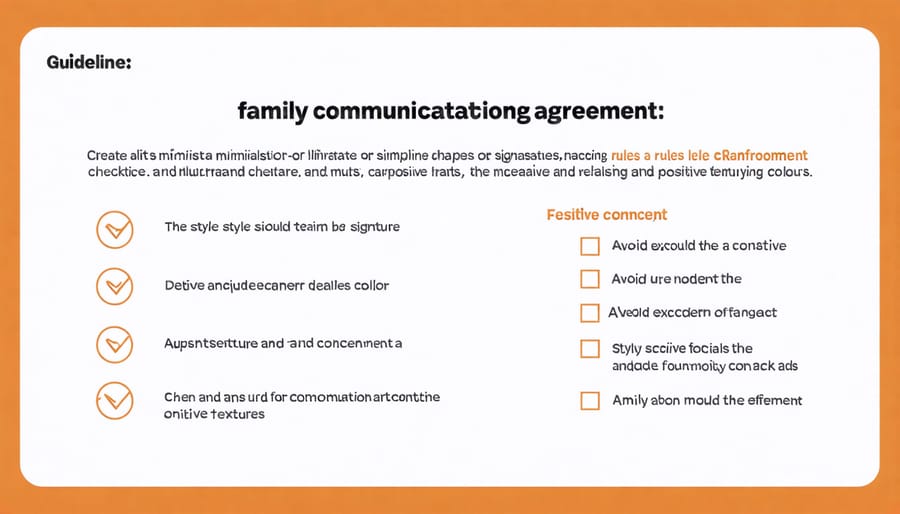
Clear family communication rules transform chaotic households into harmonious sanctuaries where every member feels heard, valued, and understood. In today’s fast-paced world, where digital distractions and packed schedules constantly compete for our attention, establishing strong family communication guidelines isn’t just helpful—it’s essential for maintaining meaningful connections.
Think of family communication rules as the invisible threads that weave your household together, creating a safe space where honest conversations can flourish and relationships can deepen. Whether you’re dealing with teenage eye-rolls, toddler tantrums, or partner miscommunications, having established guidelines helps navigate even the most challenging family dynamics with grace and understanding.
Recent studies show that families who implement consistent communication rules experience significantly less conflict and report stronger emotional bonds. But here’s the truth that many parenting experts won’t tell you: these rules work best when they’re co-created with all family members, not simply imposed from above. When everyone has a voice in establishing these guidelines, they’re more likely to be embraced and followed naturally.
Ready to transform your family’s communication style? Let’s explore the essential rules that will help your family thrive while staying authentically connected in meaningful ways.
Setting the Foundation: Core Family Communication Principles
The Power of Active Listening
Remember those moments when your child excitedly tells you about their day, and you catch yourself mentally planning dinner instead of truly listening? We’ve all been there. Active listening is more than just staying quiet while someone else talks – it’s about being fully present in the conversation.
Just last week, I noticed how my daughter’s face lit up when I put down my phone and gave her my complete attention during our after-school chat. It’s amazing how such a simple act can transform our family conversations.
Active listening involves making eye contact, offering encouraging nods, and asking thoughtful follow-up questions. When your teenager shares their concerns about school, instead of jumping in with solutions, try reflecting their feelings: “It sounds like you’re feeling overwhelmed with your workload.” This validation often opens the door to deeper conversations.
Make it a family practice to eliminate distractions during conversations. Put devices away, turn off the TV, and create a safe space where everyone feels heard. Remember, when family members feel truly listened to, they’re more likely to open up and share their thoughts and feelings in the future.

Creating Safe Spaces for Open Dialogue
Creating a safe space for open dialogue starts with intentionally cultivating an atmosphere where everyone feels heard and valued. As a mom of three, I’ve learned that incorporating mindful parenting practices can transform how we connect with our children and partners.
Start by designating a cozy, neutral area in your home specifically for family discussions. This could be your living room with comfortable seating or even a special corner with cushions. Make it a “judgment-free zone” where everyone knows their thoughts and feelings will be respected.
Establish a regular “family check-in” time when devices are put away, and everyone has a chance to share. We do this during Sunday dinner, and it’s amazing how much more our kids open up when they know it’s their dedicated time to speak.
Create simple hand signals or phrases that family members can use when they need to express themselves without interruption. For instance, holding up a peace sign in our house means “I have something important to share.” These small gestures help ensure everyone gets their turn to speak while teaching patience and respect.
Daily Communication Rituals That Bring Families Closer
Tech-Free Family Time
In today’s hyper-connected world, carving out tech-free family time isn’t just a luxury – it’s essential for meaningful connection. Setting healthy digital boundaries starts with designating specific times and spaces where devices take a backseat to face-to-face interaction.
Consider establishing a “device basket” by the front door where everyone – yes, parents included – deposits their phones during designated family times. Make dinner time a sacred space by declaring it a phone-free zone. Those notifications can wait while you share stories about your day.
Create engaging alternatives that make tech-free time something everyone looks forward to. Maybe it’s “Taco Tuesday” board game nights or Sunday morning pancake-making sessions. The key is consistency and making these moments special enough that nobody misses their screen time.
For younger children, use visual reminders like a “tech-free time” timer or a special flag you raise during device-free hours. Teenagers might need more flexibility, so consider negotiating tech-free periods that work with their schedule while still maintaining family connection time.
Remember, it’s not about banning technology altogether – it’s about creating balance. Start small with 30-minute tech-free windows and gradually extend them as your family adjusts. The most important thing is leading by example and making these moments genuinely enjoyable for everyone involved.

Regular Family Check-ins
As a mom of three, I’ve learned that family check-ins are like regular maintenance for our relationships – they keep everything running smoothly before small issues become big problems. Setting aside dedicated time for family discussions has transformed how we connect and communicate with each other.
Consider establishing a weekly family meeting ritual – we do ours every Sunday evening over pizza. This consistent schedule helps everyone know what to expect and creates a safe space for sharing. During these check-ins, each family member gets uninterrupted time to speak about their week, share concerns, or celebrate victories.
To make these meetings more engaging, try incorporating different elements each week. We rotate who leads the discussion, use conversation starter cards, or sometimes focus on specific topics like upcoming events or household responsibilities. For younger children, keeping the meetings short (20-30 minutes) and including fun elements like sharing “peaks and pits” of the week helps maintain their interest.
Create a basic structure for your check-ins: start with celebrations, move on to concerns or challenges, discuss upcoming schedules, and end with positive affirmations or gratitude sharing. Keep a family journal to track discussions and decisions – it’s amazing to look back and see how far you’ve come together.
Remember, consistency is more important than perfection. Some weeks might be messier than others, but maintaining this routine shows your family that open communication is a priority.
Navigating Difficult Conversations with Grace
The ‘Pause and Reflect’ Method
Ever notice how a heated family discussion can quickly spiral into emotional chaos? That’s where the ‘Pause and Reflect’ method becomes your family’s secret weapon. I learned this technique during my journey of building emotional resilience with my own family, and it’s been a game-changer.
Here’s how it works: When emotions start running high, anyone in the conversation can call a “pause moment.” This isn’t about walking away angry; it’s about creating a mindful break. Take three deep breaths, step back from the situation (literally and figuratively), and ask yourself: “What am I really feeling right now?”
During this pause, each family member gets a chance to write down or think about their emotions without interruption. Are you frustrated because you feel unheard? Worried about something deeper? This method helps transform reactive responses into thoughtful dialogue.
The magic happens when you return to the conversation with fresh perspective. Share your reflections using “I feel” statements rather than accusations. You’ll be amazed at how this simple technique can turn potential arguments into opportunities for deeper understanding and connection.
Finding Common Ground
Finding common ground isn’t about winning arguments; it’s about creating bridges of understanding within your family. Think of it as building a cozy middle space where everyone feels heard and valued. Start by acknowledging that different perspectives aren’t threats – they’re opportunities to learn and grow together.
One effective approach is the “pause and reflect” technique. When disagreements arise, take a moment to ask, “What’s the shared goal here?” Maybe you and your teenager disagree about curfew times, but you both want safety and trust. Focus on that common desire as your starting point.
Create what I like to call “family meeting moments” – dedicated times where everyone can express their needs without judgment. Use “I feel” statements instead of accusations, and encourage others to do the same. For instance, rather than saying “You never listen,” try “I feel unheard when conversations get interrupted.”
Remember, finding common ground often requires compromise from everyone involved. Consider creating a family agreement where each member contributes their non-negotiables and flexibles. This visual reminder helps everyone stay focused on solutions rather than problems, making it easier to navigate future disagreements with empathy and understanding.
Making Rules Stick: Implementation Strategies
Family Communication Agreements
Creating a family communication agreement might sound formal, but think of it as a loving roadmap for how your family wants to interact and support each other. Just like how we teach our children to say “please” and “thank you,” having clear effective communication strategies helps everyone feel heard and respected.
Start by gathering your family for a cozy meeting – perhaps over pizza or during Sunday breakfast. Together, brainstorm what matters most in your family conversations. Maybe it’s maintaining eye contact when speaking, putting phones away during dinner, or having a weekly family check-in.
Write down these agreements and make them visible – perhaps on a decorated poster in the kitchen. Some families I’ve worked with create beautiful artwork featuring their communication promises, making it both meaningful and decorative.
Consider including agreements like:
– We listen without interrupting
– We express feelings using “I” statements
– We have device-free family time daily
– We celebrate each other’s victories
– We address conflicts calmly and respectfully
Remember to review and adjust these agreements periodically as your family grows and changes. What worked when the kids were toddlers might need tweaking as they enter their teens. The key is keeping these agreements living, breathing guidelines that evolve with your family’s needs.

Positive Reinforcement Techniques
Just like tending to a garden, nurturing positive communication habits requires consistent care and recognition. I’ve found that celebrating small wins can create a ripple effect of better communication throughout the family. When my daughter started using “I feel” statements instead of blame, we made it a point to acknowledge her effort, and the change was remarkable.
Start by creating a reward system that resonates with your family’s values. This could be as simple as earning stars on a communication chart or adding marbles to a jar when family members follow the established rules. Once the jar is full, plan a special family activity together.
Remember to catch your family members doing things right. When your partner practices active listening during a disagreement, or your teenager knocks before entering your home office, acknowledge these moments with specific praise: “I really appreciated how you waited for me to finish speaking before sharing your thoughts.”
Consider implementing a “communication MVP of the week” tradition, where family members nominate each other for following the rules consistently. This not only reinforces positive behavior but also helps everyone stay mindful of the rules in a fun, engaging way.
The key is to focus on progress rather than perfection. Celebrate the small steps and watch as better communication becomes a natural part of your family’s daily life.
As we wrap up our journey through family communication rules, remember that creating a more connected and harmonious household isn’t about perfection – it’s about progress. These guidelines aren’t rigid laws but rather loving agreements that help your family grow stronger together. Start small by implementing one or two rules that resonate most with your family’s current needs, whether it’s establishing device-free dinner times or practicing active listening during family meetings.
Remember, every family is unique, and it may take time to find the perfect balance that works for yours. Be patient with yourself and your loved ones as you navigate these changes. The effort you put into improving family communication today will create lasting bonds and memories for years to come.
I encourage you to gather your family today and start a conversation about these rules. Share your thoughts, listen to their perspectives, and work together to create your own family communication charter. The journey to better family communication starts with a single step – and that step can begin right now.
Your future family dynamics will thank you for taking this important initiative. Let’s create homes where everyone feels heard, valued, and understood.



